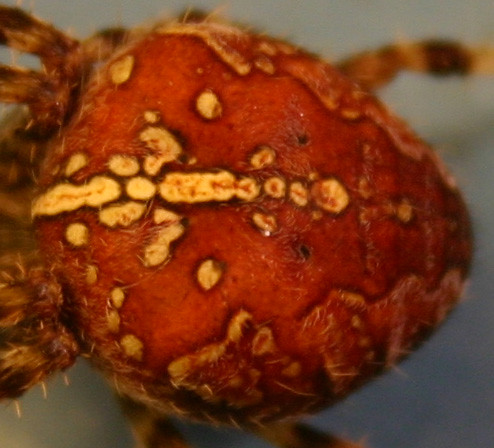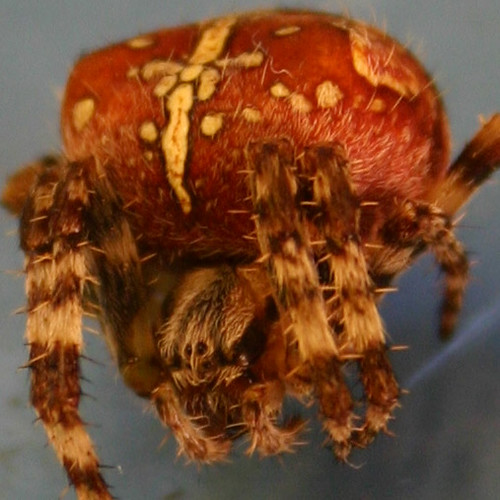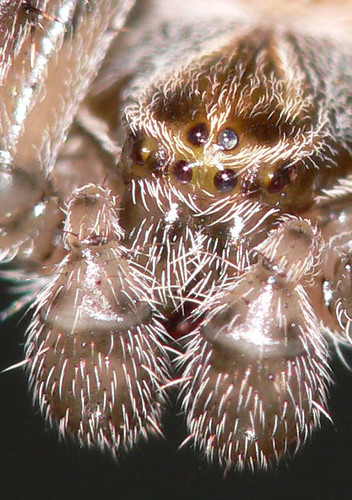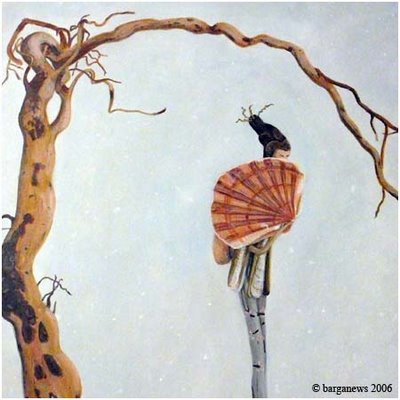Araneus diadematus-colour, eyes and reproduction

This is the common garden spider and this year the two I had in my window were very red. They will die shortly but I thought maybe they turned red to warn off from predators from eating their egg nests. I have since found out they are, anyway, very variable in colour from yellow to black but as far as I know no one knows why.
How little we know of life in our back garden.

They are watching. See those two eyes.
Some say they make their webs at windows so they can watch TV. Here is a close up of a different lady (same species), not so colourful.

But you can see what a lot of lovely eyes she has! There are eight. The two big bits at the front are, I think, the jaws (chelicera) and in poisonous spiders have fangs at their ends.
Which brings me to best bit, the web's hidden sex life, which I found described in an article on The University of Michigan's Museum of Zoology website:
"The internal reproductive organs of the Araneus diadematus resembles those of other arthopods. The female's paired ovaries lie in the abdomen and join to form a common oviduct which ends in the uterus and opens to the outside in the epigastric furrow. The female also contains a pair of spermathacae or seminal receptacles. Sperm taken in during copulation are stored here until egg-laying. In males, a common duct is formed by a pair of coiled testes in the abdomen and opens to the exterior at the centre of the epigastric furrow. The males exude their sperm through the epigastric furrow onto a sperm web and transfer it to their palps (feelers or tactile head appendages) . The terminal palpal organ is the sperm reservoir and carries out insemination through a narrow tube known as the embolus. The palpal organ serves as a pipette which can suck up and release seminal fluid.
The blood pressure within the male palp increases so that sclerotized projections such as hooks and spines elevate into position to grasp on to the surface of the epigyne. Only the correct palp will fit into the appropriate epigyne. This ensures the successful mating of mating only between individuals of the same species. The males search for a female and are rather cautious when approaching a female, becuase they always risk being dealt with as prey. The male embraces the female's abdomen during copulation and inserts one bulb. Afterwards, the male leaves and his palps are refilled with sperm. This process may only be repeated a few times since the life expectancy of the male is shorter than that of the female.
Before the female starts making her egg sac, she withdraws for several days into her retreat. She then spins a thin layer of single tightly woven silk threads. The first layer is molded by her abdominal movements into a disk known as a basal plate. Then she crawls underneath the basal plate and continuously turns around in circles spinning the cylindrical wall. The palps are held in contact with one side of this wall while spinnerets are placed on the opposite wall. After about two hours, the cylindrical wall grows to 5 mm in height. The cocoon size is directly related to the size of the spider, but not necessarily with the number of eggs it will hold. The female waits for a few minutes and begins to lay her eggs and cover them in a tight pack of silk threads. This becomes the cover plate in which the spider keeps adding layers of thread. The loop mesh ultimately wraps around the entire surface of the egg sac. The female will remain close to the cocoon for the next few days in case the threads need repairing. The female dies a few days after the egg sac is built. The cocoon will appear unchanged externally, while the spiderlings develop internally for a few months. The offspring will emerge in spring, and they will release fine threads of silk from their spinnerets to be carried off by the wind to new locations. Their journey through the air is called ballooning. Wherever each spider drops from the sky will be where its new life begins.
(Dewey 1993; Foelix 1982; Preston-Mafhan 1996)."
Veronica Godines (author), Southwestern University.
Stephanie Fabritius (editor), Southwestern University.
http://animaldiversity.ummz.umich.edu/site/accounts/information/Araneus_diadematus.html




